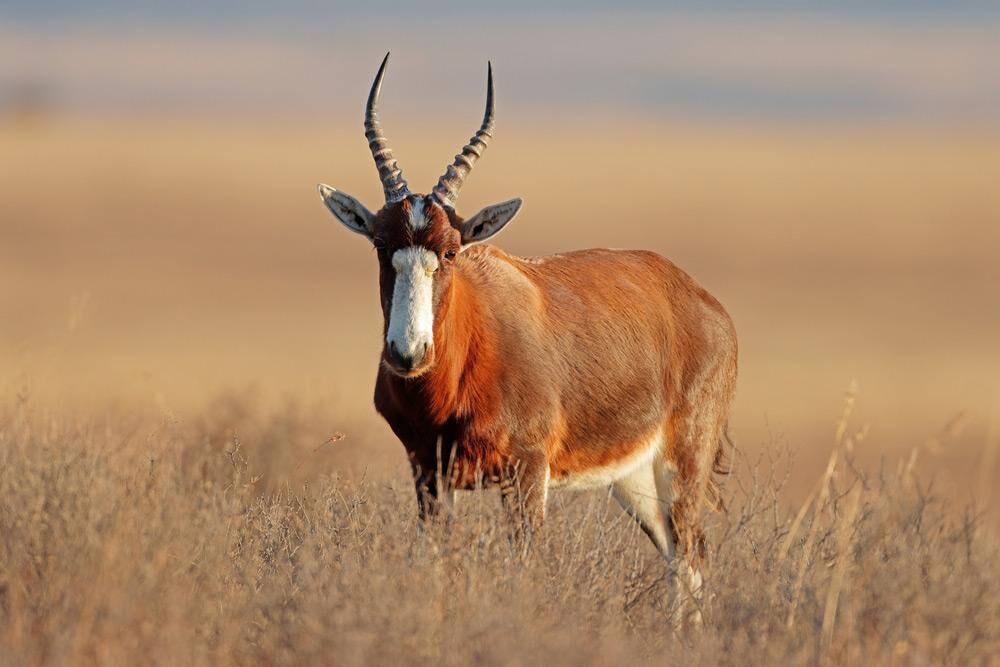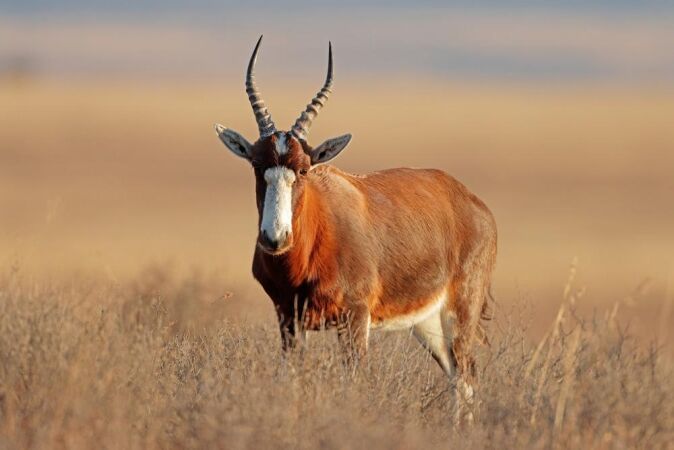

The blesbok (Damaliscus pygargus phillipsi) is native to South Africa and remains a popular choice for Africa plainsgame hunting. Although years ago, the blesbok was nearly extinct, but their numbers are steadily climbing, and they have been successfully introduced into Namibia, where they are thriving. Their current status with the International Union of Conversation of Nature (IUCN) is “least concern.”
The blesbok is a medium-sized antelope, found throughout most of South Africa, including the Eastern Cape, Free State, North West, Mpumalanga and KwaZulu-Natal. They prefer a habitat of open grasslands with access to water available. They dislike wooded areas.
There are three different social structures within a blesbok herd, namely territorial males, female herds, and bachelor groups. These bucks are diurnal and active during the early morning and late afternoon, with their activity dropping during the heat of the day.
Female blesbok gestates for 9-10 months, giving birth to one calf. Births peak annually in November and December.
Unlike many other antelope species, the blesbok newborn stays with the mother in the herd and is not hidden from danger or predators.
They are herbivorous grazers, consuming grass as their main food source, as well as herbs. They migrate to follow the rains and the fresh, newly grown grasses.
There are many predators, apart from man, hunting the blesbok in South Africa. Their main predators include lions, leopards, African wild dogs, spotted hyenas, and cheetahs. Calves may be attacked by jackals and eagles.
Name:
Damaliscus pygargus phillipsi
Male Weight:
143-176 pounds
Male Shoulder Height:
34-40 inches
Horns:
14-20 inches
Range:
Southern Africa
Gestation Period:
9-10 months
Life span:
17 years
The Blesbok is a medium-sized antelope with S-shaped horns
When on your Africa plains game hunting safari, look for a medium-sized antelope that is similar in shape to the tsessebe and hartebeests. Their coat is reddish-brown, with light cream-colored limbs and underbelly, and they sport a white blaze on their faces. The blaze is broken by a brown band between their eyes. Both males and females have lyre-shaped horns that can reach up to 14-20 inches long, with the female’s horns being shorter and thinner. They have long, pointed heads with light-brown ears.
The best time of the day for a big game hunting safari targeting the exquisite blesbok is in the early morning or late afternoon when they are grazing in and around water. A hide can be set up near the water, allowing the hunter the perfect opportunity to take a great shot. The walk-and-stalk method is also often used, but with their superb senses on high alert, it is difficult to get close enough to easily identify a trophy ram, since both sexes have horns. Invest in a good pair of binoculars and be prepared to wait it out.
Blesbok hunting in South Africa is immensely popular and they are one of the most hunted species in the country. They are very alert and constantly on the lookout for danger, which makes it difficult to get within shooting range without being spotted. Your trophy blesbok should have an average shoulder height of 35 inches, a horn length of 13-15 inches, and weigh at least 130 pounds.
Blesbok tend to be quite skittish so the hunting trip may require some stalking. The best caliber for a Blesbok hunt in Africa ranges from a .243 to any of the thirty calibers fitted with a high-quality scope. 130 to 150 grain bullets are perfect. Larger calibers like a .375 or even a .458 can be used if they are loaded with monolithic or solid tips.
Search from our range of Hunts across various popular destinations in Africa.
Find A Hunt